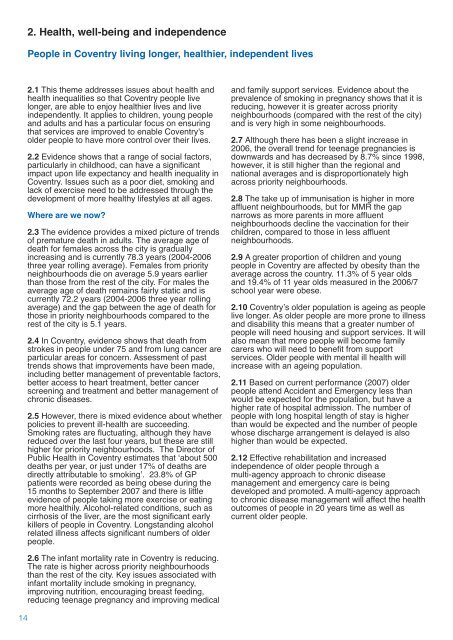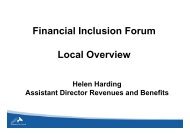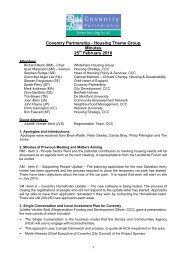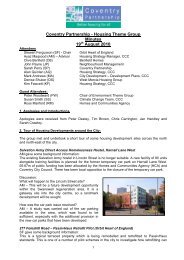Sustainable Community Strategy - Coventry Partnership
Sustainable Community Strategy - Coventry Partnership
Sustainable Community Strategy - Coventry Partnership
Create successful ePaper yourself
Turn your PDF publications into a flip-book with our unique Google optimized e-Paper software.
2. Health, well-being and independence<br />
People in <strong>Coventry</strong> living longer, healthier, independent lives<br />
2.1 This theme addresses issues about health and<br />
health inequalities so that <strong>Coventry</strong> people live<br />
longer, are able to enjoy healthier lives and live<br />
independently. It applies to children, young people<br />
and adults and has a particular focus on ensuring<br />
that services are improved to enable <strong>Coventry</strong>'s<br />
older people to have more control over their lives.<br />
2.2 Evidence shows that a range of social factors,<br />
particularly in childhood, can have a significant<br />
impact upon life expectancy and health inequality in<br />
<strong>Coventry</strong>. Issues such as a poor diet, smoking and<br />
lack of exercise need to be addressed through the<br />
development of more healthy lifestyles at all ages.<br />
Where are we now?<br />
2.3 The evidence provides a mixed picture of trends<br />
of premature death in adults. The average age of<br />
death for females across the city is gradually<br />
increasing and is currently 78.3 years (2004-2006<br />
three year rolling average). Females from priority<br />
neighbourhoods die on average 5.9 years earlier<br />
than those from the rest of the city. For males the<br />
average age of death remains fairly static and is<br />
currently 72.2 years (2004-2006 three year rolling<br />
average) and the gap between the age of death for<br />
those in priority neighbourhoods compared to the<br />
rest of the city is 5.1 years.<br />
2.4 In <strong>Coventry</strong>, evidence shows that death from<br />
strokes in people under 75 and from lung cancer are<br />
particular areas for concern. Assessment of past<br />
trends shows that improvements have been made,<br />
including better management of preventable factors,<br />
better access to heart treatment, better cancer<br />
screening and treatment and better management of<br />
chronic diseases.<br />
2.5 However, there is mixed evidence about whether<br />
policies to prevent ill-health are succeeding.<br />
Smoking rates are fluctuating, although they have<br />
reduced over the last four years, but these are still<br />
higher for priority neighbourhoods. The Director of<br />
Public Health in <strong>Coventry</strong> estimates that ʻabout 500<br />
deaths per year, or just under 17% of deaths are<br />
directly attributable to smokingʼ. 23.8% of GP<br />
patients were recorded as being obese during the<br />
15 months to September 2007 and there is little<br />
evidence of people taking more exercise or eating<br />
more healthily. Alcohol-related conditions, such as<br />
cirrhosis of the liver, are the most significant early<br />
killers of people in <strong>Coventry</strong>. Longstanding alcohol<br />
related illness affects significant numbers of older<br />
people.<br />
and family support services. Evidence about the<br />
prevalence of smoking in pregnancy shows that it is<br />
reducing, however it is greater across priority<br />
neighbourhoods (compared with the rest of the city)<br />
and is very high in some neighbourhoods.<br />
2.7 Although there has been a slight increase in<br />
2006, the overall trend for teenage pregnancies is<br />
downwards and has decreased by 8.7% since 1998,<br />
however, it is still higher than the regional and<br />
national averages and is disproportionately high<br />
across priority neighbourhoods.<br />
2.8 The take up of immunisation is higher in more<br />
affluent neighbourhoods, but for MMR the gap<br />
narrows as more parents in more affluent<br />
neighbourhoods decline the vaccination for their<br />
children, compared to those in less affluent<br />
neighbourhoods.<br />
2.9 A greater proportion of children and young<br />
people in <strong>Coventry</strong> are affected by obesity than the<br />
average across the country. 11.3% of 5 year olds<br />
and 19.4% of 11 year olds measured in the 2006/7<br />
school year were obese.<br />
2.10 <strong>Coventry</strong>ʼs older population is ageing as people<br />
live longer. As older people are more prone to illness<br />
and disability this means that a greater number of<br />
people will need housing and support services. It will<br />
also mean that more people will become family<br />
carers who will need to benefit from support<br />
services. Older people with mental ill health will<br />
increase with an ageing population.<br />
2.11 Based on current performance (2007) older<br />
people attend Accident and Emergency less than<br />
would be expected for the population, but have a<br />
higher rate of hospital admission. The number of<br />
people with long hospital length of stay is higher<br />
than would be expected and the number of people<br />
whose discharge arrangement is delayed is also<br />
higher than would be expected.<br />
2.12 Effective rehabilitation and increased<br />
independence of older people through a<br />
multi-agency approach to chronic disease<br />
management and emergency care is being<br />
developed and promoted. A multi-agency approach<br />
to chronic disease management will affect the health<br />
outcomes of people in 20 years time as well as<br />
current older people.<br />
14<br />
2.6 The infant mortality rate in <strong>Coventry</strong> is reducing.<br />
The rate is higher across priority neighbourhoods<br />
than the rest of the city. Key issues associated with<br />
infant mortality include smoking in pregnancy,<br />
improving nutrition, encouraging breast feeding,<br />
reducing teenage pregnancy and improving medical
















